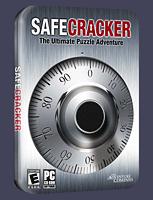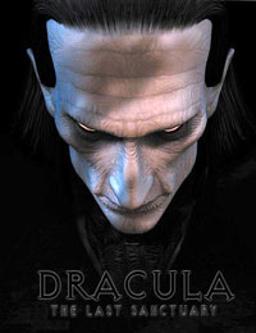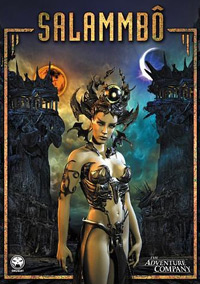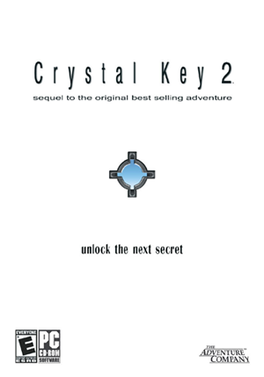
Myst III: Exile is the third title in the Myst series of graphic adventure puzzle video games. While the preceding games in the series, Myst and Riven, were produced by Cyan Worlds and published by Brøderbund, Exile was developed by Presto Studios and published by Ubi Soft. The game was released on four compact discs for both Mac OS and Microsoft Windows on May 8, 2001; versions for the Xbox and PlayStation 2 were released in late 2002. A single-disc DVD version was later released for Windows and Mac OS.

Cryo Interactive Entertainment was a French video game development and publishing company founded in 1990, but existing unofficially since 1989 as a developer group under the name Cryo.

DreamCatcher Interactive Inc. was a Canadian video game publisher founded in 1996 by Richard Wah Kan. It was best known for its adventure games. In 2006, the company became a subsidiary of JoWooD Entertainment. In 2011, the company went into administration along with its parent JoWooD and all assets were purchased by Nordic Games Holding. The DreamCatcher Interactive brand is currently being used as a publishing label for THQ Nordic.

Atlantis: The Lost Tales is a 1997 fantasy adventure video game developed and published by Cryo Interactive Entertainment. Interplay Productions published the game in North America, where it released on September 30, 1997. The game is named after its initial and most important setting, Atlantis. It is the first in a Myst-like series, and was followed by Atlantis II, Atlantis III: The New World, Atlantis Evolution and The Secrets of Atlantis: The Sacred Legacy.

Message in a Haunted Mansion is the third installment in the Nancy Drew point-and-click adventure game series by Her Interactive. The game is available for play on Microsoft Windows platforms as well as Game Boy Advance. It has an ESRB rating of E for moments of mild violence and peril. Players take on the first-person view of fictional amateur sleuth Nancy Drew and must solve the mystery through interrogation of suspects, solving puzzles, and discovering clues. There are two levels of gameplay: Junior and Senior detective modes. Each mode offers a different difficulty level of puzzles and hints, but none of these changes affect the actual plot of the game. The game is loosely based on a book entitled The Message in the Haunted Mansion (1995).

Atlantis II, known as Beyond Atlantis in North America, is a 1999 graphic adventure game developed and published by Cryo Interactive. The sequel to Atlantis: The Lost Tales, it follows the story of Ten, a mystical being that travels across time to defeat the Bearer of Dark. Players assume the role of Ten and solve puzzles in locations such as Ireland, the Yucatán Peninsula of Mexico and China.

Atlantis III: The New World,, is a 2001 fantasy adventure video game developed and published by Cryo Interactive, with Dreamcatcher Interactive publishing the game in North America. David Rhodes composed the musical score. It is the third game in the Atlantis series by Cryo, as well as the last one made before Cryo's closure. It was followed by Atlantis Evolution in 2004.

Kheops Studio was an independent video game development studio created in September 2003. Its games were published by Microïds, which acquired the brand and intellectual property as insolvency assets of Cryo Interactive in 2002. The company was co-founded by Benoît Hozjan, who also served as the creative director for the studio and Stéphane Petit, who served as technical director. Kheops developed adventure games for the PC platform and released several major successful games. The studio is best known for creating games that have been described by the developer as "cultural entertainment", that is, games which are heavily drawn from historical or literary sources to include a mixture of history and fiction. After filing for bankruptcy, the studio was closed down in January 2012.

Echo: Secrets of the Lost Cavern is a computer adventure game released in July 2005. It was developed by Kheops Studio and published by The Adventure Company. It is very similar to previous Kheops Studio games; the interface and gameplay are almost identical to Return to Mysterious Island. The player takes the role of Arok, a 15-year-old European Homo sapiens from the Paleolithic period.

Safecracker: The Ultimate Puzzle Adventure is a 2006 puzzle adventure game developed by Kheops Studio and published by The Adventure Company. It is the spiritual successor to Daydream Software's 1997 title Safecracker.

Dracula 2: The Last Sanctuary is a 2000 graphic adventure video game developed by Wanadoo Edition and jointly published by Index+, France Telecom Multimedia, Canal+ Multimedia and Cryo Interactive. Originally released for Microsoft Windows and Mac OS, it was ported to the PlayStation in 2002. In 2012, a slightly modified version developed and published by Microïds was released for iOS and OS X, and, in 2013, for Android. In 2014, the remade iOS/OS X/Android version was made available on Steam. There were dubbing mutations in French, English, Spanish, German, Italian, Hungarian and Czech.

Dracula: Resurrection is a 1999 graphic adventure video game developed by Index+. Set in 1904 Transylvania, the game serves as a follow-up to Bram Stoker's novel Dracula. Seven years after the death of Count Dracula, Jonathan Harker's wife Mina finds herself mysteriously drawn back to Transylvania. Jonathan subsequently travels to Borgo Pass in an effort to rescue her. The player assumes the role of Jonathan and uses a point-and-click interface to solve puzzles and navigate the game's world, often with the help of an object called the Dragon Ring.

Egypt 2: The Heliopolis Prophecy is an adventure video game developed and published by Cryo Interactive for the PC and PlayStation in 2000. It was released for Mac OS X in May 2012. Egypt 2 follows Egypt 1156 B.C. and is followed by Egypt III.

Egypt III, known as The Egyptian Prophecy in North America, is a 2004 graphic adventure game developed by Kheops Studio and published by The Adventure Company. The player must solve an array of ancient riddles that will help a dying Pharaoh survive and restore Egypt to glory. The game is the third and final game in the Egypt trilogy, following Egypt 1156 B.C. and Egypt II: The Heliopolis Prophecy. In 2010, Microïds released an adaptation of the game, split into parts, for the Apple iPhone.

The New Adventures of the Time Machine is an adventure video game released in 2000, developed and published by Cryo Interactive. It is based on H. G. Wells' novella The Time Machine.

Salammbo: Battle for Carthage is a first-person perspective adventure video game. It began development at Cryo Interactive, but the company went bankrupt during production. The Salammbo team was ultimately acquired by DreamCatcher Interactive, which finished the game's development.

Riddle of the Sphinx: An Egyptian Adventure is a 2000 graphic adventure game developed by Old World Studios and published by DreamCatcher Interactive. It received a sequel, entitled The Omega Stone: Riddle of the Sphinx II, in 2003. A remastered version, Riddle of the Sphinx: Awakening, was released in 2021.

The Legend of the Prophet and the Assassin is an adventure game by Arxel Tribe. It is the sequel to Pilgrim: Faith as a Weapon. It was released in October 2000 for Windows. The game is inspired by the work of Brazilian novelist Paulo Coelho. A sequel, The Secrets of Alamût was released in March 2001.

Crystal Key 2, known in Europe as Evany: Key to a Distant Land, is a 2004 graphic adventure game developed by Canadian studio Earthlight Productions, together with Kheops Studio. It was published by The Adventure Company, and is the sequel to the 1999 title The Crystal Key.

Traitors Gate is a 1999 graphic adventure game developed by Daydream Software. Set in a reproduction of the Tower of London, it follows the story of Raven, an American special agent trying to steal and replace the Crown Jewels of England to safeguard them from a rogue operative. The player assumes the role of Raven and solves puzzles within the Tower while evading the guards. Progression through the game is nonlinear and under a time limit: the player may solve certain challenges in multiple ways, but must win before 12 hours elapse.






















